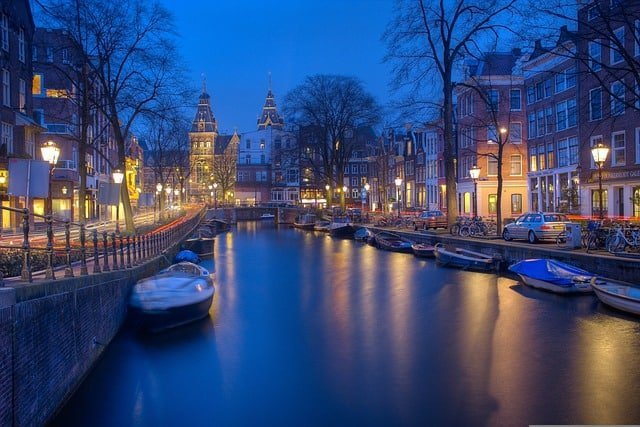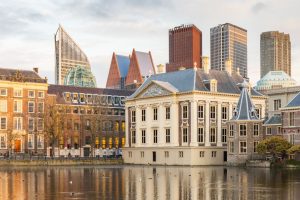Explore the rich history and architectural wonder of the Portuguese Synagogue in Amsterdam, a testament to the city's vibrant Jewish community and their contribution to the cultural tapestry of the Netherlands.
Introduction: A timeless treasure in Amsterdam
As one of the oldest and most prominent landmarks in Amsterdam, the Portuguese Synagogue is a timeless treasure that continues to fascinate visitors from all over the world. Located in the heart of the city's Jewish quarter, this magnificent building stands as a testament to the rich history and culture of the Jewish community in Amsterdam. With its stunning architecture, impressive library and unique history, the Portuguese Synagogue is a must-see for anyone interested in Jewish heritage and culture. Whether you're a history buff, an architecture buff or simply looking for a glimpse into Amsterdam's rich cultural tapestry, the Portuguese Synagogue is an experience you won't soon forget.
Entering the synagogue is like stepping back in time, as visitors are transported to a world that has remained virtually unchanged for centuries. From the intricate carvings and decorations on the walls to the soaring vaulted ceilings and stunning chandeliers, the synagogue is a true masterpiece of Baroque architecture. But the beauty of the Portuguese synagogue goes beyond its physical appearance. It is a living monument to the Jewish community in Amsterdam, a testament to resilience and strength in the face of adversity.
Why the name 'Portuguese Synagogue'?
Despite its location in the heart of Amsterdam, the Portuguese Synagogue gets its name from an unexpected source. In the 16th century, Portugal was a world power with a vast colonial empire, and many Jews fled there to escape persecution in other parts of Europe. However, in 1496 King Manuel I of Portugal issued a decree that forced all Jews to convert to Catholicism or leave the country. Many chose to leave, and a significant number settled in Amsterdam, where they established a thriving Jewish community. These Portuguese Jews brought with them a unique cultural and religious heritage, which is reflected in the architecture and traditions of the synagogue.
The Portuguese Synagogue was built in the 17th century, at the height of Amsterdam's Golden Age, when the city was a hub of trade and commerce. The founders of the synagogue were members of the Portuguese Jewish community, who wanted to create a place of worship that would reflect their heritage and tradition. They invited the best artisans and craftsmen of the time to create a building that would be both beautiful and functional. The result was a masterpiece of Baroque architecture, with soaring arches, intricate carvings and stunning chandeliers.
A glimpse into the past: when was the synagogue built?
The Portuguese synagogue in Amsterdam was built in the 17th century between 1671 and 1675. It was designed by the architect Elias Boman, who was inspired by the Italian Baroque style of architecture. The synagogue was built during the Dutch Golden Age, a period of prosperity and artistic achievements in the Netherlands. During this period, the Dutch Republic was a center of trade and commerce, and Amsterdam was one of the richest cities in Europe.
The construction of the synagogue was funded by the Spanish Jewish community, which settled in Amsterdam after being expelled from Portugal. They wanted to create a place of worship that would reflect their cultural and religious heritage. The synagogue was built on the site of a previous synagogue, which was destroyed by fire in 1654. The new building was designed to be magnificent and impressive, with a large central hall that can accommodate up to 1,200 worshipers.
The synagogue was built using traditional materials and techniques, such as bricks and wooden frames. It was also designed to be functional, with large windows that let in natural light and a wooden floor that can be covered with sand to absorb the sound of footsteps. The interior of the synagogue was decorated with intricate carvings, ornate chandeliers and beautiful stained glass windows. The center of the synagogue is the Ark of the Covenant, the Ark of the Covenant containing the Torah books. It is made of intricately carved wood and is one of the most impressive features of the synagogue.
What makes his architecture unique?
The Portuguese Synagogue in Amsterdam is known for its unique architectural style, which combines elements of Italian Baroque and traditional Jewish design. The exterior of the building is plain and unadorned, with a plain brick facade and a row of arched windows. However, the interior is a masterpiece of ornate decoration and intricate carvings.
One of the most prominent features of the synagogue's architecture is the use of light. The large windows in the walls and ceiling allow natural light to flood the space and create a feeling of openness and grandeur. The interior is also lit by dozens of chandeliers, which hang from the ceiling and cast a warm glow on the entire room.
Another unique feature of the synagogue's architecture is the use of wood. The entire building is built of a wooden frame covered with bricks and plaster. The wooden beams and wooden columns are exposed, giving the interior a warm and rustic feeling. The wooden floor is also a unique feature of the synagogue, as it was designed to be covered with sand to absorb the sound of footsteps and create a crowded atmosphere during prayer.
Aron Kodesh, or Ark of the Covenant, is another remarkable feature of the synagogue's architecture. It is located in the center of the building and is decorated with intricate carvings and golden accents. The Ark of the Covenant contains the books of the Torah, which are considered the holiest objects in Judaism. The ark is surrounded by a series of columns and arches, which create a sense of depth and perspective in space.
Etz Haim Library: a knowledge base
The Etz Chaim Library is one of the oldest and most important Jewish libraries in the world. It is located inside the Portuguese Synagogue in Amsterdam and contains a huge collection of books, manuscripts and documents related to Jewish history and culture. The library has a rich and fascinating history, and is considered a valuable resource for scholars and researchers.
- History of the library:
The Tree of Life Library was founded at the end of the 17th century, shortly after the arrival of Portuguese Jews in Amsterdam. The community quickly established a school and a library, which served as a center for learning and scholarship. Over the centuries the library grew and expanded, and it became a repository of Jewish knowledge and culture. - the collection:
The Etz Chaim library contains over 30,000 books and manuscripts, many of them rare and priceless. The collection includes works on Hebrew law, philosophy, history and literature, as well as works on science, medicine and other subjects. The library also contains a number of unique and important documents, such as letters and manuscripts of famous Jewish scholars and leaders. - Conservation efforts:
Preservation of the Etz Haim library is a constant and ongoing effort. The books and manuscripts are delicate and fragile, and require careful handling and preservation. In recent years, the library has undergone a major renovation and restoration, which included the installation of climate-controlled storage facilities as well as the digitization of many of the library's most important works. - Access to the library:
Access to the Etz Haim library is limited, and is generally restricted to scholars and researchers who have a specific research interest. However, the library does offer guided tours and other educational programs for visitors interested in learning more about Jewish history and culture. The library is also open to members of the Jewish community in Amsterdam, who use it as a resource for learning and study.
How did the synagogue serve the community?
The Portuguese Synagogue in Amsterdam served as a center of Jewish life and culture for the Jewish community in the city. Since its establishment in the 17th century until today, the synagogue has played an important role in the social, cultural and religious life of the community.
One of the most important functions of the synagogue was as a place of prayer. The synagogue was designed to accommodate a large number of worshippers, and the community would gather there for daily prayers, as well as for special events and holidays. A choir also performed in the synagogue, which added to the beauty and solemnity of the services.
In addition to its religious function, the Portuguese synagogue also served as a center for social and cultural activities. Concerts and other cultural events took place in the synagogue, as well as lectures and discussions on a variety of topics. These events were open to both members of the Jewish community and non-Jewish visitors, and helped foster a sense of community and understanding between different groups.
The synagogue also played an important role in the education of the community's children. The synagogue's school, known as "Talmud Torah", provided a traditional Jewish education for boys and girls, teaching them Hebrew, Halacha and other subjects. The school was an important part of the community, and helped ensure the continued transmission of Jewish knowledge and culture from generation to generation.
The role of the synagogue in World War II: a story of survival
During World War II, the Portuguese Synagogue played a crucial role in the survival of the Jewish community in Amsterdam. When the Nazis occupied the city and began rounding up Jews for deportation, the synagogue was a hiding place for many Jewish families. The leaders of the synagogue and the members of the synagogue worked tirelessly to protect their fellow Jews, sometimes at great risk to themselves.
The synagogue's role in the resistance was not limited to providing shelter. The synagogue archives were used to create fake identity cards for the Jews in hiding, which allowed them to avoid detection by the Nazis. The synagogue was also used as a center for resistance activity, when community members used the building as a meeting place to plan and coordinate their efforts.
Despite the dangers involved, the synagogue remained open throughout the war, providing a place of refuge and hope for the Jews of Amsterdam. The leaders and members of the synagogue were determined to do everything in their power to protect their community and preserve Jewish life and culture in the city.
Unfortunately, not everyone was able to be saved. Many members of the community were deported to concentration camps and did not survive the war. However, the efforts of the synagogue and its members saved countless lives and ensured the continuation of the legacy of the Jewish community in Amsterdam.
Today the Portuguese synagogue stands as a testimony to the resilience and determination of the Jewish people in the face of persecution and hardship. The building itself survived the war largely intact, even though it was located in the heart of the Jewish quarter, which was badly damaged during the war.
The archives of the synagogue, which played such an important role in the resistance, are now part of the Etz Chaim library, one of the oldest Jewish libraries in the world. The library contains a treasure of Jewish texts and documents, including many that were saved from destruction during the war.
Restoration efforts: bringing the synagogue back to life
In the years after World War II, the Portuguese synagogue underwent a major restoration effort to repair the damage caused by the war and return the building to its former glory. The restoration work was carried out by a team of skilled artisans and craftsmen, who worked tirelessly to ensure that the building was restored to its original design.
One of the main challenges facing the restoration team was the preservation of the synagogue's unique architecture. The building's wooden roof, which is one of its defining features, was badly damaged during the war and had to be completely rebuilt. The restoration team worked closely with experts in traditional woodworking techniques to recreate the roof using the same methods and materials that were used when the synagogue was first built.
In addition to repairing the damage caused as a result of the war, the restoration team also made several improvements to the structure to ensure it would be more suitable for modern use. This included installing modern heating and lighting systems, as well as adding new facilities such as a visitor center and gift shop.
Today, the Portuguese Synagogue is a thriving center of Jewish culture and learning, attracting visitors from all over the world. The synagogue is open to the public for tours, and visitors can explore the building's unique features, including its stunning stained glass windows and ornate wooden ark.
The restoration of the Portuguese Synagogue was a labor of love for the many people involved in the project, and serves as a testament to the continuing importance of this historic building. By preserving the synagogue for future generations, we are able to ensure that the heritage of Amsterdam's Jewish community continues to be celebrated and remembered for years to come.
Today's Synagogue: Center for Jewish Culture and Learning
Today, the Portuguese Synagogue is a thriving center of Jewish culture and learning. The synagogue has become a popular destination for visitors from all over the world who come to explore the rich history and cultural heritage of the Jewish community in Amsterdam. Below are some of the ways in which the synagogue serves as a center for Jewish culture and learning:
- 1. Religious services:
The Portuguese Synagogue continues to be an active place of worship for the Jewish community in Amsterdam. Regular religious prayers are held in the synagogue, including Shabbat and holiday prayers. - 2. Cultural events:
In addition to religious services, the synagogue also hosts a variety of cultural events throughout the year. These events include concerts, lectures and exhibitions celebrating Jewish culture and history. - 3. Educational programs:
The Etz Chaim library, located inside the synagogue, offers a variety of educational programs and resources for visitors. These programs include lectures, workshops and guided tours that explore the history and cultural significance of the synagogue and its collections.
The synagogue's role as a center for Jewish culture and learning is not limited to its physical location in Amsterdam. The synagogue also serves as a symbol of Jewish resilience and survival, inspiring people around the world to learn more about Jewish history and culture.
In recent years, the synagogue has also become a popular destination for Jewish tourists visiting Amsterdam. Visitors can explore the synagogue's many unique features, including its stunning architecture and rich history. The synagogue's gift shop offers a variety of souvenirs and books that allow visitors to take a piece of Jewish culture home with them.
Conclusion: A legacy of resilience and diversity
The Portuguese Synagogue in Amsterdam is not just a beautiful building or a tourist attraction, it is a symbol of Jewish resilience and survival. Despite facing persecution and discrimination throughout history, Amsterdam's Jewish community has persevered and thrived, leaving a lasting impact on the city's culture and history. The Portuguese Synagogue is a testament to this legacy, serving as a physical embodiment of the community's rich history and cultural heritage.
Moreover, the synagogue's cultural and educational programs have helped promote diversity and understanding in Amsterdam and beyond. By sharing the rich history and culture of the Jewish community in Amsterdam with visitors from around the world, the synagogue helps foster a greater understanding and appreciation of different cultures and religions.
As we continue to face challenges in our world today, the legacy of the Portuguese Synagogue serves as a reminder of the importance of resilience, diversity and community. By coming together to celebrate and preserve our cultural heritage, we can create a more inclusive and connected world for future generations.
The Portuguese Synagogue in Amsterdam:
| attribute | Date of construction | architect | מקום |
|---|---|---|---|
| architecture | 1675 | Jacob Van Kampen | Amsterdam, Netherlands |
| style | Limestone | Baroque and Rococo | Gold and paintings |
| size | Length 48.5 m, width 15.5 m and height 15 m | 1,200 MAN | estimated. 1.2 million euros (4.7 million ILS) |
| history | the 17th century | A place of prayer for the Jews of Spain | Museum open to the public |
The Portuguese synagogue in Amsterdam remains a symbol of religious tolerance and diversity, reflecting the city's famous past and standing as a reminder of the resilience and contribution of its Jewish community.



















